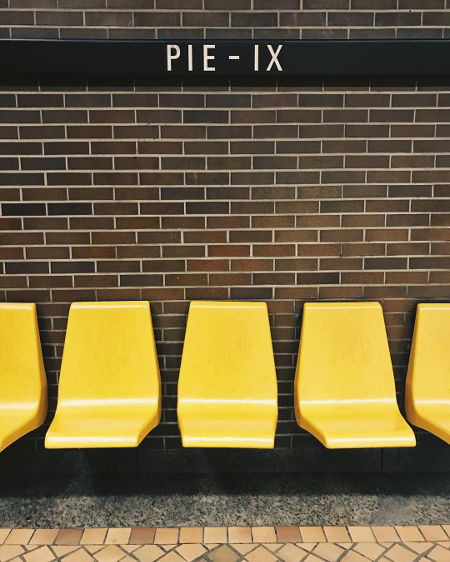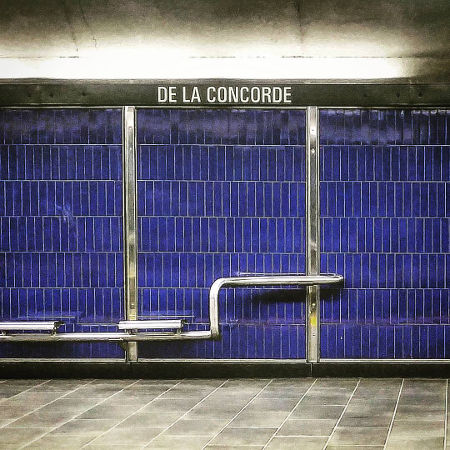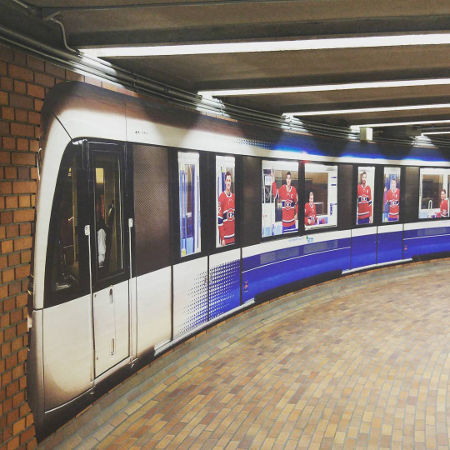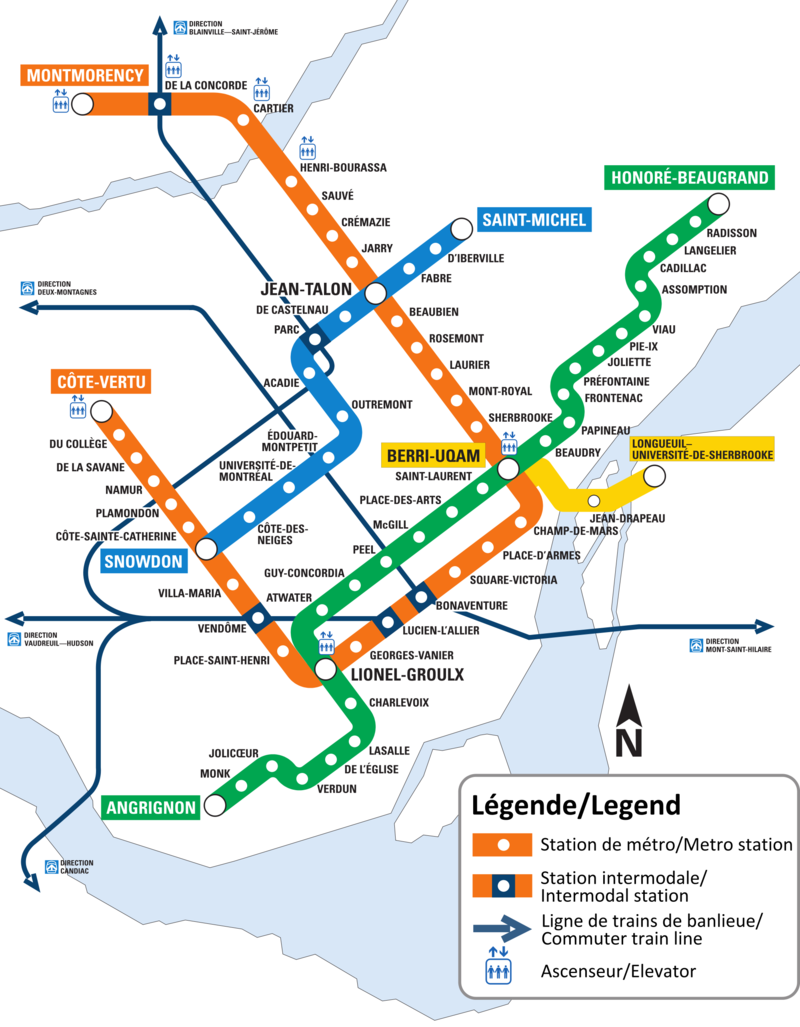The Montreal Metro System is operated by the Société de Transport de Montréal ( STM) that is also in charge of the city bus system.
The system as a whole has 68 stations spread over an area of 69 kilometers and spread over four different metro lines that overlap with each other at different points. The metro system can be recognized on the streets and on the different maps due to its blue square logo with a white arrow in the centre, pointing downwards.
The Montreal Metro System isn’t only a fast transport system that is the most used in Canada, but it’s the third most used by people throughout North America, behind the New York Metro and that of Mexico City. 52 years after it’s creation, the Montreal Metro is still the most important means of transport in city, with more than one million trips per day.
Metros in Canada: Montreal
The Montreal Metro System had encountered numerous problems before the construction plans were approved. From 1910, different proposals were submitted, but were rejected and postponed when the city had to face the consequences of the First World War, the Great Depression and the Second World War. The final plans reused several of the plans that had been previously proposed and they were finally approved in 1961.
The construction of the first two lines, the green and orange lines, started in 1962 and these lines gradually began to work from 1966.
The original plans included a third line that would use some of the existing rail lines to reach the northwest of the city. Whilst the plans were waiting to be approved, Montreal was chosen to host Expo 67, a large global fair designed to show off the achievements of different nations.
The fair forced the city to reconsider their plans and finally they decided to construct a fourth line to transport the large quantity of visitors that they were expecting to receive. Line 4, or the yellow line, started working in 1967; but during the construction, line 3 was cancelled. The result is a metro system with interrupted numbers that only contains the lines 1,2,4 and 5.
The success of the yellow line meant that Montreal was chosen to host the 1976 Olympic Games, this again forced the city to adapt to these new events. As part of the new and approved plans, they decided to extend lines 1 and 2 and construct an additional line; line 5, or the blue line.
Through these projects and proposals that were approved, as the Montreal Metro System had to adapt to the development and demands of the city; the green line reached its current extension in 1976, the blue line reached it in 1988 and the orange line accepted its last addition in 2007. The yellow line hasn’t received any extensions since its initial construction in 1967.
 Montreal Metro
Montreal Metro
Currently there are new plans being considered. Some have been approved and others are still under discussion, but the majority are focused on extending existing lines and not adding additional lines.
Lines and Stations
The Montreal Metro System has four different lines that are operated by the Société de Transport de Montréal ( STM), they are distributed throughout the city to take users to the north, east and centre of the island of Montreal.
Together, the four lines have 68 stations spread over 69 kilometers. Every line has a number and a color that make it easy to identify the different lines on the maps. Usually the color of each line is used to refer to each of them.
The Green Line
The line stretches over 22 kilometers, most of this runs through Montreal from northeast to southwest, passing under the city’s commercial zone and connecting the Angrignon terminal to the south, with Honoré-Beaugrand to the north.
- Line Color: Green
- Line Number: 1
- Number of Stations: 27
- Length of the Line: 22,1 kilometers
- Time Taken to Travel the Whole Line: 38 minutes
- Hours: 5:30 am to 12:35 am; Saturdays from 5:30 am to 01:05 am
Stations: Angrignon, Monk , Jolicoeur, Verdun, De l'Église, LaSalle, Charlevoix, Lionel-Groulx, Atwater, Guy-Concordia, Peel, McGill, Place-des-Arts, Saint-Laurent, Berri-UQAM, Beaudry, Papineau, Frontenac, Préfontaine, Joliette, Pie-IX, Viau, Assomption , Cadillac, Langelier, Radisson, Honoré-Beaugrand
The Orange Line:
At 30 kilometers in length, this line is the longest of the four lines on the Montreal Metro System. The line follows a “U” shaped path that connects the Côte-Vertu terminal in the northwest with the Montmorency terminal in the Navel city north of Montreal.
- Line Color: Orange
- Line Number: 2
- Number of Stations: 31
- Length of the Line: 30 kilometers
- Time Taken to Travel the Whole Line: 49 minutes
- Hours: 05:30 am to 12:30; Saturdays from 05:30 am to 01:00
Stations: Côte-Vertu, Du Collège, De La Savane, Namur, Plamondon, Côte-Sainte-Catherine, Snowdon, Villa-Maria, Vendôme, Place-Saint-Henri, Lionel-Groulx, Georges-Vanier, Lucien-L'Allier, Bonaventure, Square-Victoria-OACI, Place-d'Armes, Champ-de-Mars, Berri-UQAM, Sherbrooke, Mont-Royal, Laurier, Rosemont, Beaubien, Jean-Talon, Jarry, Crémazie, Sauvé, Henri-Bourassa, Cartier, De La Concorde, Montmorency
The Yellow Line:
At only 4 kilometers in length, this is the shortest line in the system and it was also the first line to leave the island of Montreal. The yellow line connects the Berri-UQAM terminal with the Longueuil-Université-de-Sherbrooke terminal, passing through the tunnel that goes under the St. Lawrence River. It was initially constructed to be able to transport the large amount fo visitors that they were expected to receive because of Expo 67.
- Line Color: Yellow
- Line Number: 4
- Number of Stations: 3
- Length of the Line: 4,25 kilometers
- Time Taken to Travel the Whole Line: 6 minutes
- Hours: 5:30 am to 01:00 am; Saturdays from 5:30 am to 01:30 am
Stations: Berri-UQAM, Jean-Drapeau, Longueuil–Université-de-Sherbrooke

The Blue Line
This is the most recent line of the Montreal Metro System and is 9.7 kilometers long, you can depart from the Snowdon station on the orange line and go to the Saint-Michel terminal in the northeast.
- Line Color: Blue
- Line Number: 5
- Number of Stations: 12
- Length of the Line: 9,7 kilometers
- Time Taken to Travel the Whole Line: 16 minutes
- Hours: 5:30 am to 12:45 am; Saturdays from 5:30 am to 01:15 am
Stations: Snowdon, Côte-des-Neiges, Université-de-Montréal, Édouard-Montpetit, Outremont, Acadie, Parc, De Castelnau, Jean-Talon, Fabre, D'Iberville, Saint-Michel
Times and Frequency
The Green Line and The Orange Line:
The green and orange lines run from 5:30 am, for six days a week, until 12:35am, expect on Saturdays, when the service extends until 1:05am. During peak hours (7-9am and 4-6pm), the metros of these two lines pass every 3 to 4 minutes and every 4 to 10 minutes for the rest of the day. At weekends, it’s every 6-12 minutes.
The Yellow Line:
The yellow line runs every day of the week from 5:30am until 1:00am, except on Saturdays when the service is extended until 1:30am. During peak hours (7-9am and 4-6pm), trains pass every 3 to 5 minutes and every 5-10 minutes at weekends.
The Blue Line:
This line works from 5:30am until 12:45am, except on Saturdays when the service is extended until 1:15am. During peak hours (7-9am and 4-6pm), the trains pass every 3 to 5 minutes and every 5 to 10 minutes for the rest of the day. During the weekend, they pass every 8 to 11 minutes.
Connections
Connections Between Lines:
The connections between lines are free when you don’t leave the station.
- A connection can be made between the green line and the orange line at the Lionel-Groulx and Berri-UQAM stations.
- A connection can be made between the green and yellow lines in the Berri-UQAM station.
- A connection can be made between the orange and the blue lines at the Snowdon and Jean-Talon stations.
- A connection can be made between the orange line and the yellow line at the Berri-UQAM station.
Connections with Other Systems:
The company in charge of the Montreal Metro System, the Montreal Transport Society, is also in charge of the the city’s bus system, meaning that connections between both means of transport are free within a 120 minute range from the first validation.
The Metropolitan Transport Network (Réseau de transport métropolitain) is a public transport company that operates in the Montreal region, offering a regional train service to Montreal, Laval and the surrounding communities. The company offers two types of tickets: Tram and Train. The tram tickets offer free connections to the entire metro system in Montreal and to the city’s bus system. However the Montreal Metro doesn’t offer tickets that allow users to go onto the trains of the Metropolitan Transport Network.
Prices, Records y Passes
OPUS Card
The OPUS card is an electronic card of which you can upload the different available tickets and passes. These cards can be purchased at any metro station’s machines or windows. It’s non-refundable and is valid for four years. To benefit from the reduced rates, users who meet the conditions (children or over 65 year olds) must have an OPUS card with a picture. Price of the card: 6 Canadian Dollars (US $4.6)

Tickets
You can buy the different types of tickets in the machines and windows that are found in all metro stations and at points of sale that are distributed throughout the city.
Unit Ticket: This ticket is valid for a single journey, but it includes transfers from the bus to the metro; or vice-versa. This ticket is valid for 120 minutes from the first validation. This is the only ticket that you can buy directly on the buses, but only by giving the exact amount of money (the drivers don’t offer change). Price: 3.25 Canadian Dollars (US $2.49)
Two-Way Ticket: This ticket includes two journey’s and includes a free connection between the buses and metros. With this ticket, every transfer is much cheaper than to buy two Unit Tickets separately. The two journeys must be used by the same person. Price: 6 Canadian Dollars (US $4.6) Reduced Rate: 4 Canadian Dollars (US $3)
Ten Route Ticket: This ticket is valid for ten trips and includes a free connection between the buses and metros for each trip. It’s cheaper than buying a Unit Ticket for each separate trip. Each of the ten journeys is valid for 120 minutes from the first validation. Price: 27 Canadian Dollars (US $12.6) Reduced Rate: 16.50 Canadian Dollars (US $12.6)
Unlimited Ticket for an Afternoon: This ticket allows you to travel unlimitedly on the buses and metros from 6pm until 5am of the next day. Price: 5 Canadian Dollars (US $3.8) Price: 13.75 Canadian Dollars (US $10.5) Price: 10 Canadian Dollars (US $7.65)
Unlimited Ticket for 3 Days: With this ticket, you can travel unlimitedly on the buses and metros for three days (72 hours) from the first validation of the ticket. Price: 18 Canadian Dollars (US $13.8)
Passes:
As well as the tickets that focus on casual users, the Montreal Metro System also offer different passes for more frequent users.
Weekly Pass: This permits you to travel unlimitedly from Monday until midnight on Sunday. Price: 25.75 Canadian Dollars (US $19.7) Reduced Rate: 15.75 Canadian Dollars (US $12)
Monthly Pass: Valid from the first to the last day of the month. Price: 83 Canadian Dollars (US $63.4)
Rules, Advice y Notices
- Children that are 5 or under travel for free.
- It’s permitted to travel with pets, as long as they are enclosed in a suitable pet carrier.
- It’s prohibited to smoke, consume alcoholic beverages or ride bikes in the stations.
- To make sure that you have a safe and quiet trip, the Montreal Metro Syste, recommend the following:
- Keep distance. Wait until the metro completely stops before coming close to it and look for the painted lines on the floor.
- Take care of your personal items.
- Do not keep the doors open after hearing the closing signal.
- Never go down onto the metro tracks.
Curious Facts
- The Montreal Metro System is the most used in Canada.
- As well as being the most used in Canada, the Montreal Metro System is the third most used by people throughout North America, behind the New York Metro and that of Mexico City.
- The Montreal Metro System was inspired by the Paris Metro, this can be seen in the design of the stations and the types of trains used.
- The initial plans included 5 different lines. Line 3 was later cancelled, but Line’s 4 and 5 kept their names. This means that the numbering of the lines isn’t consecutive and the Montreal Metro System has ended up with the Line’s 1,2,4 and 5, without ever having a line 3.
Future Expansions
Different plans have been proved to extend the system and adapt to the development of the city, but not all of the plans are in the construction phase. Some were approved while others are in the process of discussion. Some of the most important expansions are:
- To extend the Blue Line from the Saint Michel station to the Saint Leonard and Anjou, through five new stations.
- To extend the Orange Line from the Côte Vertu station to the Bois Franc regional train station, located to the northwest.
- They are considering extending the Yellow Line to Longueuil by constructing six new stations.
- The city of Laval is considering extending the Orange Line into its territory.
Connection to the Airport
Although Montreal has two airports, only one of them receives commercial passenger flights, the Montréal-Pierre Elliott Trudeau International Airport, known simply as Trudeau Airport. None of the four lines of the Montreal Metro System go directly to the airport, but there is a bus that leaves passengers at 2 subway stations.
The 747 bus is part of the company responsible for the Montreal metro and bus system, so buying a ticket for the 747 bus allows you to travel on the metro and some of the metro tickets also allow you to use this service:
Ticket for the 747 Bus: The ticket costs 10 Canadian Dollars (US $7.64) and as well as allowing you to travel on the 747 bus, it also allows you to travel unlimitedly on the buses and metros for 24 consecutive hours from the first validation.
Metro Tickets That Allow You To Travel 747:
- Unlimited Ticket for a Day
- Unlimited Ticket for Three Days
- Unlimited Ticket for a Weekend
- Weekly Pass
- Monthly Pass
The 747 service operates 24 hours every day of the week and offers two different services:
- A bus that travels between the airport and the Lionel Groulx terminal, without stopping in between. From this terminal, you can access the green or orange line to continue your trip. The journey takes around 25 to 35 minutes.
- A bus that travels between the airport and the Berri UQAM metro station, making 11 stops along the way. The entire journey takes 45 to 70 minutes. From the Berri UQAM station, you can access the green, orange and yellow lines to continue your journey.
In addition to the 747 bus line, there are other ways to get to Montreal Airport from the city center. These options include:
Line 378 (378-E), also by bus, which provides connections to Montreal-Trudeau Airport (Yul Aéroport Montréal-Trudeau). The first stop is Yul Aéroport Montréal-Trudeau and the last stop is Saint-Michel / Sauvé. Line 378 operates daily and has a total of 65 stops on its route. The estimated total travel time on Line 378 is about 49 minutes, with a frequency of 10 minutes, and the ticket price is 3.50 CAD.
Taxi: A taxi from the city center to the airport costs between 40 and 50 CAD. The journey takes approximately 35 minutes.
Private Transportation Service: There are several companies that offer private transportation services from the city center to the airport. The price of the private transportation service varies depending on the company and the type of vehicle you choose. The journey takes about 30 minutes.
What to see whilst using the Montreal Metro
The old part of Montreal (Vieux Montreal): This part of the city is without a doubt one of the most visited places by tourists and appreciated by its residents. It’s full of cobbled streets, galleries and restaurants with a charming European air. Its buildings date back to the seventeenth and nineteenth centuries, and include the twin towers of the Basilica of the Notre Dame and Place Jacques Cartier. The Place d’Armes stations and the orange line will take you directly to the old part of Montreal.
Parc Jean Drapeau: This is the park where the famous Expo 67 world fair was held. Today it’s a museum that is dedicated to ecological themes and full of activities that are suitable for the whole family. Around the museum, you will find other attractions like the La Ronde amusement park and the Stewart Museum. The yellow line takes you directly to the island where all of these tourist sites are located.
Botanical Gardens: Known as Parc Maisonneuve, the Montreal Botanical Gardens contain a mixture of Japanese gardens, Chinese gardens, greenhouses and exhibitions of orchids and bonsai. The Pie XI station on the green line is a five minute walk from the botanical gardens.
Rue Sherbrooke: This is without a doubt one of the most elegant parts of the city and is home to some of the most important museums and institutions in the city, like the McCord Museum, the Musée des Beaux Arts and the McGill University. The McGill station on the green line is a few minutes walk from the McCord Museum and the McGill University, whilst the Peel station that is also on the green line, leaves you closer to the Musée des Beaux Arts.
Montreal metro map
- Passengers/Day 1050800
- Fares: 1.67
- 24h operation: No
- Air Conditioning: No
- Walk between platforms: No
- Driverless trains: No
- Screen Doors Platforms: No
- Average Speed: 40km/h
- Max. Speed: 72km/h
- Operator: Société de transport de Montréal
- $3
- Montreal Metro Official Website
Help us
If you consider that the information we provide is wrong, not accurated, outdated, translation contains errors, and you would like to help us to improve the file...you can contact us here.
Feel free to contact us if you dont find the system you're looking for and we'll add it as soon as we can!
Thank you very much!







